
What To Feed A Newborn Puppy: The Complete Guide
Alex Vicente • Updated on August 1, 2023
- This review contains affiliate links. Read more here.
- Not a substitute for professional veterinary help.
Newborn puppies are so cute and cuddly, but they also are very fragile.
The diet that they receive within the first 12 hours of life is critical to their ability to survive the first few weeks outside of the womb.
Puppies who do not receive antibodies and growth hormones during the first two days of life may show signs of Fading Puppy Syndrome and ultimately they will die.
Newborn puppies must receive colostrum for the first two days.
Puppies need to nurse every three hours for at least six to seven weeks of life. Orphans must be bottle-fed.
During weaning, puppies can be introduced to soft foods.
Finally, fully weaned puppies can be fed solid puppy kibble.
People who find themselves the proud owners of a newborn puppy without a mama dog to take care of it have a big job ahead.
The human owner will need to take the place of the mama dog and give the puppy as much canine-style care as possible.
The reward for saving a puppy is more love and loyalty than can be imagined.
This guide will go over the general requirements and steps to give a newborn puppy a fighting chance.
Other resources that you may be interested in:
- Best Dog Food for Senior Small Breeds
- The Best Harness for a French Bulldog: Everything You Need To Know
- English Bulldog Pitbull Mix: The Ultimate Guide
Table of Contents
Symptoms of Fading Puppy Syndrome

First, we will go over something that no one wants to encounter, and that is fading puppy syndrome. People need to know about this syndrome as they embark on feeding a newborn puppy. This is a very common occurrence, even for breeders, and it is a heartbreaking thing to witness. Fading puppy syndrome refers to the symptoms that a puppy exhibits when it fails to thrive within the first few weeks of life.
- The puppy is normal at birth, showing no signs of malaise or weakness.
- Within the first two weeks, the puppy fails to gain weight, becomes dehydrated, sickly, and weak, and is unable to nurse.
- Fading puppy syndrome nearly always results in death.
- Roughly 50% of the victims of fading puppy syndrome die within the first week after birth. Attentiveness to the puppy’s weight gain and ability to ingest food is critical to treating this syndrome before it is too late.
There are several theories as to why this happens to puppies with no apparent reasons such as cleft palate. One theory is dehydration. This can occur when the mama dog is too weak to nurse, has inadequate colostrum supply, or the puppy is unable to cope with the competition for colostrum.
In cases of dehydration, owners may be able to save the puppy by administering colostrum by hand. It must be put in the mouth at an angle that promotes swallowing. Administration of fluids at the back of the throat will cause aspiration pneumonia and the puppy will die. Aspiration pneumonia is sometimes the cause for fading puppy syndrome even for those who have a mama dog to nurse from.
Another theory for fading puppy syndrome is that the puppy is unable to get enough colostrum from the mother during the first hours of life to jump-start the immune system. Then it falls prey to environmental bacteria and viruses because it is unable to fight them off. Puppies who show signs of fading puppy syndrome should be taken to the emergency vet immediately.
Now that we have covered this unhappy topic and newborn puppy owners are aware of what to look for, we will cover how to feed a newborn puppy and give it the best possible jumpstart in life.
A Puppy’s First Food is Colostrum
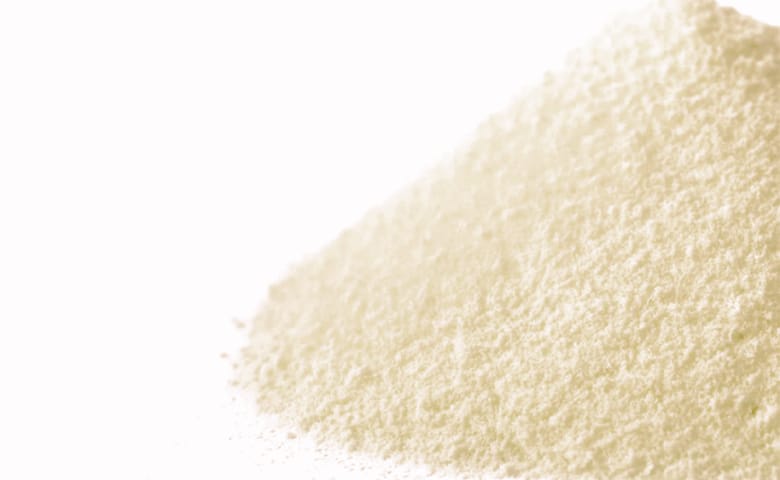
Colostrum is the first fluid that is produced by nursing mammals before the milk comes in. It is thick, yellow, and chock full of nutrition. Puppies can not skip this nutritious substance and thrive. It is debatable if a puppy who does not receive colostrum can live. This is because colostrum is the most nutritious substance that a puppy will ever eat, and this nutrition gives it a necessary boost to transition from placental feeding to milk.
When the puppy is separated from the placenta at birth, it loses the constant stream of nutrition and is birthed into a world full of bacteria and germs. It does not have antibodies to these bacteria and germs until it consumes colostrum.
- Colostrum is full of antibodies such as immunoglobulin that are built up in the mother’s immune system. These antibodies are passed directly to the puppy and give it the same immunity that the mother has. This allows it to live through the first few weeks of life with passive immunity to viruses, bacteria, and germs.
- Colostrum contains interleukins which are powerful cancer fighters. These are passed directly into the puppy’s system from the mother.
- Colostrum is rich in iron.
- Colostrum is three times more protective than the dog flu vaccine against flu viruses. Puppies who fade often fall prey to viruses and infections because they lack the antibiotic properties they would have received from colostrum.
- Colostrum builds immunity against leptospirosis, bordetella, Lyme disease, and parvovirus better than a vaccine.
- Colostrum contains the growth hormones that puppies need, in particular IGF-1 and IGF-2. These growth hormones help the puppy to heal from wounds and boost protein production for cell growth.
- Antiviral, antimicrobial, and germicidal properties of colostrum intake persist in puppies for 10 to 12 weeks as their bodies adjust to life in the world and strengthen their own immune systems.
- This early colostrum is also hydrating, which is critical to survival. This hydration also helps the puppy to maintain a constant body temperature. Puppies that are fading can not keep their temperature high enough.
The puppy must be able to consume as much of this nourishing fluid as possible during the first 12 hours and at every opportunity for the first two days after birth.
ALSO READ: What To Do When a Senior Dog Stops Eating?
Colostrum Substitutes for a Puppy

There are many reasons why a puppy may not be able to drink colostrum as quickly as it should. Sometimes the mother’s colostrum supply has failed to build up like it should in the final weeks of pregnancy, and she runs dry before she can feed all of her puppies.
Sometimes the mother is too weak to nurse, or may even die during birthing. Sometimes smaller puppies are unable to compete for available teats and breeders do not realize that one puppy has been unable to eat until it is too late and the puppy is weakening. Usually, by the time it is clear that a puppy is dehydrated and fading it is too late to save its life.
In the case of a puppy who is abandoned, orphaned, or for some other reason deprived of natural canine care, a human must step in immediately to give similar care to save the puppy. This care must immediately start with colostrum supplementation and keeping the puppy warm.
- Consult the vet immediately. They may be able to provide either plasma or serum from a healthy adult dog that contains the iron, antibodies, and growth hormones that the puppy needs to survive.
- Plasma can be administered orally or under the skin as directed by the vet.
- Bovine colostrum supplements can be purchased as a powder, a liquid, or in dosed syringes for easy oral administration.
- Goat colostrum is especially rich and easier for puppies to digest, but it may not be as readily available as bovine colostrum.
- Those who can find a goat colostrum formula should use it above other types. It is full of vitamins B, E, K, and D, and it is especially easy for puppies to digest because the milk proteins in goat’s milk are smaller.
- These supplements will not deliver all of the same canine benefits that the puppy would receive from canine colostrum, but it is a powerful immune booster and will give the puppy the strength it needs to begin nursing well from a bottle.
- Powdered supplements should be used right after mixing and discarded after 24 hours. They will grow bacteria and could harm the puppy if they are kept too long.
- Liquid supplements are more expensive and require refrigeration.
- All supplements must be fed to the puppy at room temperature. Set a refrigerated supplement in a pan of warm water and allow it to come up to temperature before feeding to the newborn puppy.
Bottle-Feeding a Newborn Puppy
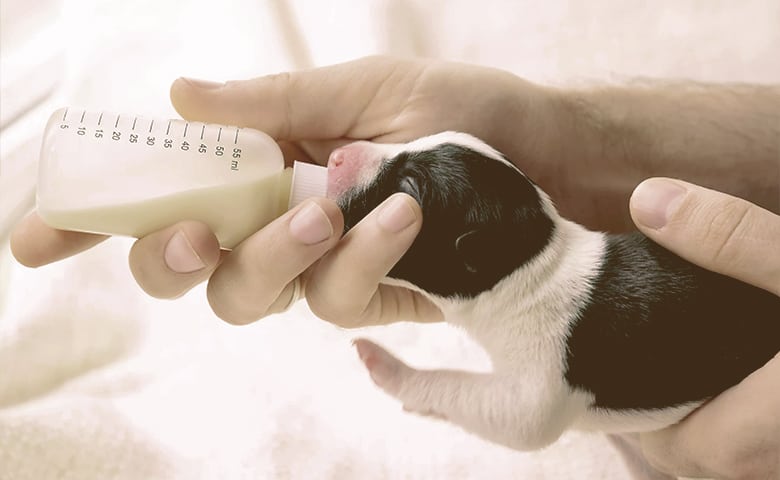
Ideally, the puppy is strong enough to bottle feed. If the puppy can suckle, then use a bottle to feed colostrum, and after a couple of days switch to a puppy formula milk substitute.
Bottles with nipples that are sized for a newborn puppy can be found at pet stores, or often at a veterinary hospital. Purchase several sets of bottles and nipples so that you always have some that are clean and sanitized and ready to use.
- Mix powdered formula in the bottle with room temperature water and allow the puppy to suckle on the nipple at its own pace. A strong puppy will take about 15 minutes to consume a full meal.
- The liquid formula must be warmed gently to room temperature before feeding. Place it in warm water and swirl the formula occasionally to help it warm evenly before feeding to the puppy. Do not make the formula warmer than room temperature or body temperature.
- Place the puppy on its stomach, and keep the head as even with the ground as possible. Think about how the puppy would be positioned if it was nursing from its mother who is laying on her side. Mimic this position as much as possible. This is how a puppy is designed to suck and swallow.
- Gently open the mouth with one finger and place the nipple on the puppy’s tongue. This should stimulate a sucking reflex. This may take a little patience and coaxing for the first couple of feeds until the puppy learns to suck from the bottle. Do not squeeze more than a single drop of milk onto the puppy’s tongue.
- Tip the bottle up slightly while the puppy eats so that it ingests less air. Tipping the bottle up causes the air to go up into the end of the bottle and helps to keep the nipple full of fluid instead of bubbles.
- Never squeeze the bottle to make more milk come out. This can cause the puppy to choke and possibly aspirate some of the formula.
- Do not enlarge the nipple holes to help the puppy eat faster. This can cause puppies to choke and even aspirate formula. This can cause aspiration pneumonia and death. Be patient and let the puppy take all the time it needs to get a nutritious meal.
- Puppies must eat at least every three hours during the waking hours of the day. Puppies who eat well during the day usually can sleep all night, especially after the first couple of weeks.
- Always discard unused puppy formula. It can be refrigerated for up to 24 hours, but after that time it must be discarded for fresh formula.
- Always wash and sanitize bottles and nipples. Milk formulas rapidly grow bacteria which can harm the puppy and cause digestive upset.
Puppies who receive early intervention before they are too weak to suckle will be able to use a bottle from the beginning. However, those who are growing weak may not have the strength to suckle. For these puppies, it will be necessary to syringe feed until they gain enough strength to have an interest in a puppy bottle.
ALSO READ: Best Dog Food for Golden Retriever
Syringe Feeding a Newborn Puppy
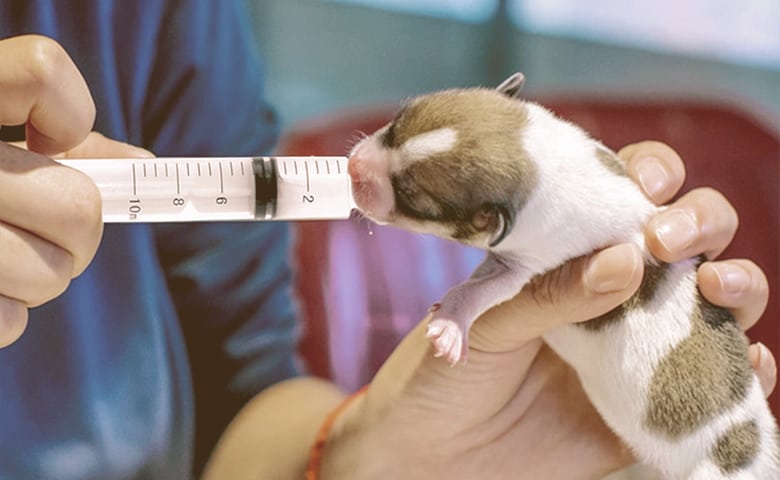
Puppies that are too weak to suckle on a puppy bottle nipple will need to be fed by an oral syringe. This must be done with utmost care because the risk of aspiration pneumonia is much greater with syringe feeding.
Puppies who are too weak to suckle may also be too weak to swallow. If liquids are forced into the mouth by a syringe and the puppy is too weak to swallow, the liquid will most likely be breathed into the lungs and cause aspiration death.
Puppies who are this weak have a very low chance of survival, but they are always worth trying to save. Many puppies have been saved by the loving care of humans who took the time to feed them drop-by-drop to help them gain the strength they need to eat.
Multiple complications arise when puppies are unable to nurse and then get to the point where they can not suckle and swallow. The first issue is dehydration. The puppy gets dehydrated very quickly, which creates a systemic weakness that is very difficult to overcome. Secondly, they do not get the antibodies that they need to fight viruses and bacteria that quickly invade their weak bodies.
This is why human intervention is critical within the first hours of a newborn puppy’s life if the mother is unable to nurse, or the puppy is orphaned or weak. Feeding the puppy with colostrum within the critical first 12 hours will give the puppy the antibodies, hydration, vitamins, and growth hormones that it needs for that initial jump-start on life.
- Some colostrum supplements come in pre-measured syringes. This is the most convenient way to feed a very weak puppy.
- Regular colostrum supplements can be mixed up and used with oral syringes.
- Whatever colostrum supplement is used, it is critical to not force the liquid into the puppy’s mouth. A stream of liquid that is unswallowed will be aspirated.
- Feed puppy with puppy lying on its tummy with the head as even to the ground as possible, just as if it was nursing. This helps the puppy to swallow properly and decreases the risk of aspiration.
- The syringe should be put into the puppy’s mouth at an angle. This will help to avoid dripping fluid straight down the lungs.
- Colostrum should be placed drop by drop on the puppy’s tongue. Allow it to swallow naturally. Forced swallowing will be detrimental to the puppy’s health. If the puppy can not swallow drops of colostrum, call a vet immediately for additional help.
- As soon as the puppy shows a willingness to suckle, try a puppy bottle with the smallest nipple available.
This type of puppy care requires time and patience, and it may or may not pay off, but it is well worth the effort. Many puppies have been saved by loving humans who are willing to take the time to nurse them to strength.
Transition the Puppy to Milk
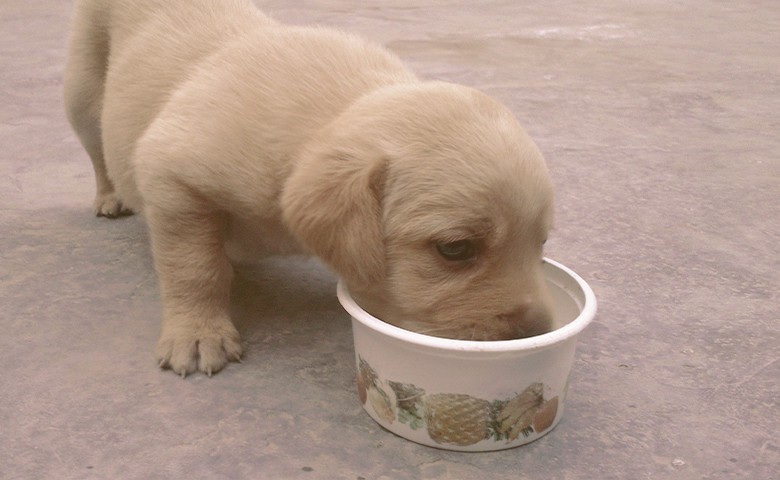
After the first two critical days, the puppy can be transitioned to a milk-based puppy formula. These can be cow’s milk-based or goat’s milk-based, depending on what you prefer and how well the puppy is doing. If the puppy seems to have a hard time digesting a cow’s milk formula, then consider transitioning to a goat’s milk formula.
Feeding a puppy regular formula requires the same process as feeding colostrum. If the puppy is doing well, then it is already growing and gaining some weight. It is hopefully nursing well and showing signs of increasing hunger.
As puppies grow their appetites and caloric needs grow rapidly. A puppy’s dietary intake is between two and three times more per pound than they need when they are adult dogs. This means that they need to eat a lot, and often.
- Puppies need to drink puppy formula from a bottle at least every three hours until they are eight weeks old.
- Puppy formula is all that is needed for the puppy until it begins to get a nice set of teeth at around four weeks old. At this time you can begin gently introducing soft canned puppy food.
- The puppy will still drink formula regularly until around eight weeks old, though it will begin eating more and more soft food as the weeks go by.
- Colostrum can also be given to puppies and even adult dogs. If the puppy needs extra strength and immunity, then keep giving colostrum as well as puppy formula. It can only do good for the puppy as it grows.
At around eight weeks of age, puppies are outgrowing the nursing phase of life. They have a nice little set of teeth, are accustomed to soft foods, and are ready to try some new and exciting foods.
Transition the Puppy to Solid Foods

Once the puppy is about four weeks old and has a nice new set of puppy teeth growing in, it is time to begin introducing the puppy to soft foods. This is a fun and exciting time for the puppy and its owner alike.
- Choose a soft canned food that has a good balance of protein, vitamins, and minerals.
- Do not transition the puppy from milk to solid foods overnight. This transition takes several weeks. Puppies should not be weaned until about eight weeks old. They need this solid start to have a healthy life in the future.
- Give the puppy a little while with the new soft food. Let it sniff and lick a little of the food. If the puppy likes to taste your fingers, then try putting a little of it on your finger and let the puppy lick it off.
- If the puppy food seems a little thick, or the puppy is not interested at all, then mix some of the canned puppy food with puppy formula. This familiar smell and flavor may help the puppy to explore the new food with more interest.
- After the hungry puppy has had some time to enjoy the new food, then give it the meal of puppy formula from a bottle.
- At every meal, present the soft food and give the puppy ample time to eat as much as it likes.
- Do not worry that the puppy will not transition. It is natural for all mammals to wean, and the puppy will do this in its own time. Weaning that is made stressful for the puppy can cause aggression and other undesirable behaviors.
- Continue to make mealtime a relaxing time with your puppy. Enjoy this time and allow the puppy to eat without being rushed or stressed.
- As the weeks go by, give the puppy a longer and longer time with solid food and give less and less milk.
- Most puppies wean completely by about eight weeks, but some puppies need a little longer. If the puppy has had a rough start, then it may need additional time suckling on a bottle. This is okay. Puppies who are allowed to wean on their own timing will be more well-balanced dogs.
The puppy will still need to eat a lot of food, even when it is completely weaned from the bottle of puppy formula. Give the puppy four meals a day until it is six months old, then decrease this to three meals a day. Ask the veterinarian for specific dietary requirements for the puppy because these requirements vary widely by breed.
Transition the Puppy to Kibble
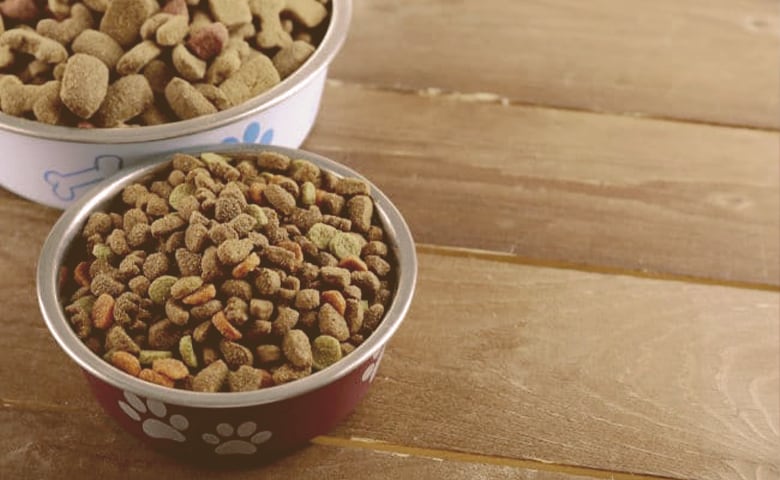
For most dog owners, the ultimate goal is to transition the puppy to kibble in preparation for a diet of adult dog kibble in the future. There are many benefits to having the puppy eat kibble. It is less expensive, it does not require refrigeration once it is opened, and kibble foods help to keep the puppy’s teeth cleaner.
- Move slowly. As with all other transitions, give several weeks of transition time to move the puppy from soft canned foods to crunchy puppy kibble.
- Always choose a puppy kibble that is appropriately sized for the breed of the dog. There are very tiny kibbles for small breed puppies and larger puppy kibbles for large breed dogs.
- Choose a puppy kibble that is well-balanced between proteins, fats, vitamins, and minerals.
- Do not choose a puppy kibble that is low fat. Canines burn fat for energy, and fat is needed to fuel proper brain growth in the puppy. Puppies that are deprived of adequate fat intake will not develop full brain potential.
- Mix puppy kibble into the soft canned puppy food a little at a time. Begin with a very small amount and gradually increase the ratio of puppy kibble to soft puppy food.
- Choose matching brand foods if possible. This will help to alleviate the digestive upset that can come from changing foods.
Puppies are considered to have reached adulthood once they are a year old. At this time puppies can begin transitioning to adult dog food and also decrease the number of meals to two per day.
Ask the vet when is the right time to transition the puppy because this timing varies per the size of the dog and the breed. In general, it will be around one year old. Smaller breeds reach maturity sooner than larger breeds, so larger breeds may need the additional caloric intake for a longer period of time.
A rule of thumb is that when the dog reaches 80% of the adult body weight for the breed, then it can be transitioned to adult kibble.
Conclusion

Puppies who are weak, unable to suckle their mothers, or are orphaned can be saved by human intervention if action is taken within the first hours or first day of life. This intervention begins with the careful administration of a colostrum supplement. After two days the puppy can be transitioned to a puppy formula and fed from a puppy bottle.
Newborn puppy care requires utmost patience, gentleness, and a commitment to nearly constant care. This early care can result in the salvation of a tiny life that gives love, joy, and loyalty for a lifetime in return.
Sources
Breeding Business – When to switch from puppy to adult dog food.
PetMD – Weaning Puppies
The Nest – How Long Do New Puppies Need to Nurse?
The Dog Place – Fading puppies
VCA Hospitals – Fading Puppy Syndrome in Dogs
PetMD – Feeding the Orphaned Puppy
Pet Side – Bottle Feeding Puppies/
Revival Animal – Breeder’s Edge® Nurture Mate
Breeding Business – Colostrum for dogs
VCA Hospitals – Colostrum
WebMD – Caring for a Newborn Puppy


